Holly Thompson's Blog, page 36
November 2, 2011
On Seeing Shaun Tan
Alas, the title of this post is not "On Meeting Shaun Tan" but I feel so lucky to have attended his JBBY sponsored lecture in Tokyo on October 22. All 500 tickets had sold out and there was a line of at-the-door hopefuls.
Shaun Tan's stories have been on my radar for a long time, and my favorites are The Arrival
[image error]
and Tales from Outer Suburbia.
[image error]
All of Shaun Tan's stories deal with notions of belonging, of insiders and outsiders, and home. As the son of a Chinese-Malaysian father and an English-Irish-Australian mother and married to a Finnish woman, Tan is well-poised to tackle ideas of straddling cultures. Yet his stories do so indirectly, by wedding realism with fantasy, by combining observational painting and drawing with imaginary stories, or as Tan said, by exploring "reality in all its strangeness."
At the event on October 22, we first were treated to a screening of the Academy Award-winning film "The Lost Thing" based on his picture book of the same title, in which a large, living, lost object is found by a boy and brought home like a puppy. Tan explained that he loves drawing emotions that feel real but are dislocated into another place.
When Tan took the stage he immediately told us a story, "Eric" from Tales from Outer Suburbia. He narrated it straight-faced, as if he were sharing an actual family memory of an exchange student's visit, while simultaneously showing illustrations from the story. Since Eric is about the size and shape of a maple leaf, the effect was hilarious.
The Arrival, as Tan explained, though wordless, is heavily research-based--he had collected and researched numerous immigrant stories and studied waves of mass migration. He discovered common emotions of anxiety and loneliness in what felt like disconnected places. Then he used fantasy to create a world unfamiliar to all readers and himself, and to remind readers of the strangeness of ordinary life. Though Tan has never migrated himself, the book is one of the most compelling and moving migration stories I have ever encountered. See this page from Shaun Tan's website on the inspiration for and process of creating The Arrival.
Tan said that he doesn't set out to tell a meaningful story, that he's actually just having fun painting. But since painting is a slow process that allows for lots of time to think, when he steps back from a painting he's often surprised to see the depth of meaning that has come through. Like the silent water buffalo in one of his stories who wordlessly points people toward a solution, painting can also point vaguely in a direction that seems interesting and worth exploring.
Shaun Tan spoke with an interpreter for about 90 minutes--and what a full 90 minutes it was. His talk covered his early drawings, background and training, family, research, discussions of The Lost Thing, The Arrival, several stories from Tales from Outer Suburbia, The Red Tree, and new work.
After an intermission, author/illustrator Satoshi Kitamura who'd been spotted in the audience, plus another Japanese author/illustrator whose name I couldn't catch were brought on stage and invited to ask questions of Shaun Tan. A few questions that had been submitted by the audience were also directed at Tan. In response to one question, he said, "There is almost nothing more distressing to me than a perfect line. I like the nervousness and unfinished look of working by hand." He likened his philosophy to that of Japanese calligraphy where there is mastery without control, and the artist is "at peace with the accident."
So I didn't get to meet him personally or host an SCBWI event. But I feel so incredibly lucky to have heard Shaun Tan give such a full and inspiring talk on his books that have meant so much to me. I look forward to his next works juxtaposing observation and imagination and exploring the gap between the familiar and the unfamiliar.
Shaun Tan's stories have been on my radar for a long time, and my favorites are The Arrival
[image error]
and Tales from Outer Suburbia.
[image error]
All of Shaun Tan's stories deal with notions of belonging, of insiders and outsiders, and home. As the son of a Chinese-Malaysian father and an English-Irish-Australian mother and married to a Finnish woman, Tan is well-poised to tackle ideas of straddling cultures. Yet his stories do so indirectly, by wedding realism with fantasy, by combining observational painting and drawing with imaginary stories, or as Tan said, by exploring "reality in all its strangeness."
At the event on October 22, we first were treated to a screening of the Academy Award-winning film "The Lost Thing" based on his picture book of the same title, in which a large, living, lost object is found by a boy and brought home like a puppy. Tan explained that he loves drawing emotions that feel real but are dislocated into another place.
When Tan took the stage he immediately told us a story, "Eric" from Tales from Outer Suburbia. He narrated it straight-faced, as if he were sharing an actual family memory of an exchange student's visit, while simultaneously showing illustrations from the story. Since Eric is about the size and shape of a maple leaf, the effect was hilarious.
The Arrival, as Tan explained, though wordless, is heavily research-based--he had collected and researched numerous immigrant stories and studied waves of mass migration. He discovered common emotions of anxiety and loneliness in what felt like disconnected places. Then he used fantasy to create a world unfamiliar to all readers and himself, and to remind readers of the strangeness of ordinary life. Though Tan has never migrated himself, the book is one of the most compelling and moving migration stories I have ever encountered. See this page from Shaun Tan's website on the inspiration for and process of creating The Arrival.
Tan said that he doesn't set out to tell a meaningful story, that he's actually just having fun painting. But since painting is a slow process that allows for lots of time to think, when he steps back from a painting he's often surprised to see the depth of meaning that has come through. Like the silent water buffalo in one of his stories who wordlessly points people toward a solution, painting can also point vaguely in a direction that seems interesting and worth exploring.
Shaun Tan spoke with an interpreter for about 90 minutes--and what a full 90 minutes it was. His talk covered his early drawings, background and training, family, research, discussions of The Lost Thing, The Arrival, several stories from Tales from Outer Suburbia, The Red Tree, and new work.
After an intermission, author/illustrator Satoshi Kitamura who'd been spotted in the audience, plus another Japanese author/illustrator whose name I couldn't catch were brought on stage and invited to ask questions of Shaun Tan. A few questions that had been submitted by the audience were also directed at Tan. In response to one question, he said, "There is almost nothing more distressing to me than a perfect line. I like the nervousness and unfinished look of working by hand." He likened his philosophy to that of Japanese calligraphy where there is mastery without control, and the artist is "at peace with the accident."
So I didn't get to meet him personally or host an SCBWI event. But I feel so incredibly lucky to have heard Shaun Tan give such a full and inspiring talk on his books that have meant so much to me. I look forward to his next works juxtaposing observation and imagination and exploring the gap between the familiar and the unfamiliar.
Published on November 02, 2011 20:19
October 9, 2011
Cake Illustration
It's birthday season again--pressure for me to come up with cake designs. Since part of yesterday's party took place at the beach, I went with that theme.
First the land, water and sky.
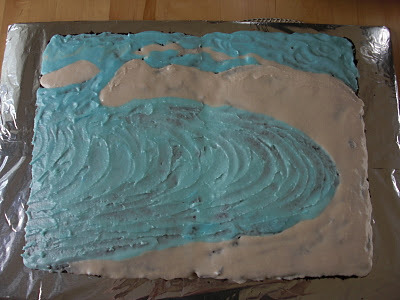
Then I sprinkled granulated kokuto (brown sugar) for the beach sand and maccha green tea powder mixed with sugar for the green hills. A piece of dried mango became the Enoshima lighthouse.
[image error]
Next, a few details--dried mango fishing boats and of course...fish.
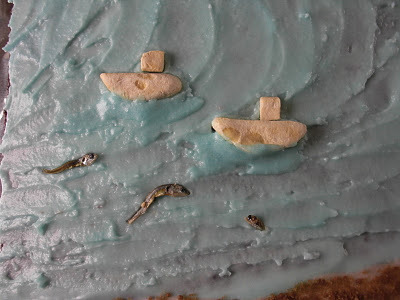
Jelly beans became surfboards, and sprinkles worked for the people on the beach. And I sculpted Mount Fuji from hagi (mochi covered with crushed black sesame, filled with azuki) and added a snow cap of powdered sugar.
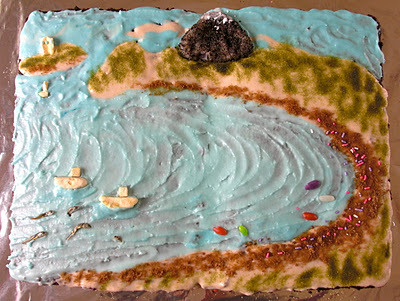
Okay, so the lower left corner of the cake wasn't so popular, but one guest actually requested a fish.
First the land, water and sky.

Then I sprinkled granulated kokuto (brown sugar) for the beach sand and maccha green tea powder mixed with sugar for the green hills. A piece of dried mango became the Enoshima lighthouse.
[image error]
Next, a few details--dried mango fishing boats and of course...fish.

Jelly beans became surfboards, and sprinkles worked for the people on the beach. And I sculpted Mount Fuji from hagi (mochi covered with crushed black sesame, filled with azuki) and added a snow cap of powdered sugar.

Okay, so the lower left corner of the cake wasn't so popular, but one guest actually requested a fish.
Published on October 09, 2011 17:16
September 29, 2011
Orchards Book Trailer
Hope you enjoy this trailer for Orchards created by ASIJ library intern Ellen Yaegashi. Thanks, Ellen!
And Orchards has been nominated for an ALA YALSA 2012 Best Fiction for Young Adults--check out the YALSA list of nominated titles.

And Orchards has been nominated for an ALA YALSA 2012 Best Fiction for Young Adults--check out the YALSA list of nominated titles.
Published on September 29, 2011 17:06
September 13, 2011
Return to Ishinomaki--Six Months After
Last week, just before the six-month anniversary of the March 11 earthquake and tsunami, I traveled north to Tohoku to complete another volunteer work stint with the NGO Peace Boat in Ishinomaki, Miyagi Prefecture. In late April and early May, during Golden Week, I had joined an 8-day trip. This time I joined a 4-night, 3-day trip--2 nights on overnight bus and 2 nights staying at the Kasuka Fashion factory building.
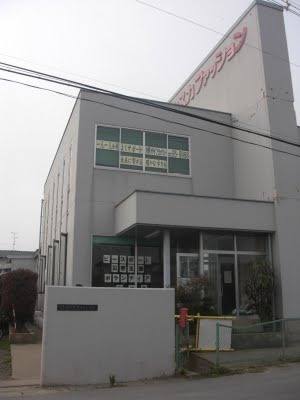 our lodgingsConditions for volunteers have changed dramatically since my first trip when we had to bring our own tents, food, water and gear. Now most gear can be borrowed, lunch and dinner are served, water is available, tents are not necessary, and there are even...daily showers.
our lodgingsConditions for volunteers have changed dramatically since my first trip when we had to bring our own tents, food, water and gear. Now most gear can be borrowed, lunch and dinner are served, water is available, tents are not necessary, and there are even...daily showers.
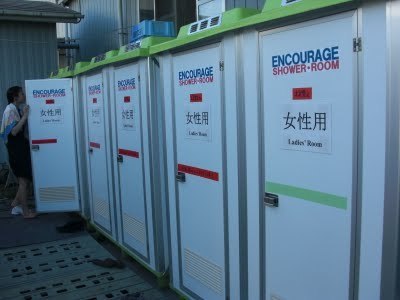 shower stallsAnd Ishinomaki itself looked quite different from the sludge shoveling days of spring. Most of the debris has been heaped into organized mountains, mud has been removed, destroyed cars have been gathered and stacked, and shells of houses stand amid cleared open areas now filling with weeds.
shower stallsAnd Ishinomaki itself looked quite different from the sludge shoveling days of spring. Most of the debris has been heaped into organized mountains, mud has been removed, destroyed cars have been gathered and stacked, and shells of houses stand amid cleared open areas now filling with weeds.
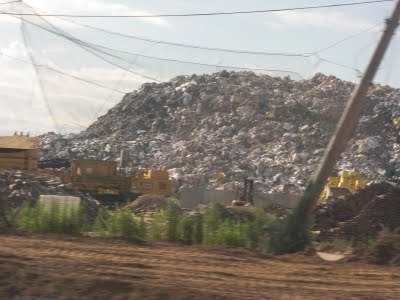 debris mountain
debris mountain
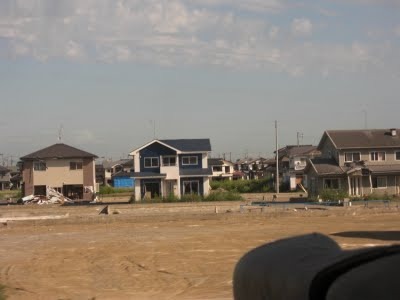 miles and miles of damaged homes The volunteer work that our team was assigned to do was all in the same location--Oginohama, a small fishing community part way out the Oshika Peninsula. The tsunami had overrun the fishing port and poured over the torii gate at the base of the shrine. Our efforts for the three days were to ready the shrine and surrounding grounds so that the locals remaining in the area could hold their important annual shrine festival. On day one, many teams worked together to clean the neglected 200 steps up to the mountaintop shrine, scrubbing away moss and mud for hours on end.
miles and miles of damaged homes The volunteer work that our team was assigned to do was all in the same location--Oginohama, a small fishing community part way out the Oshika Peninsula. The tsunami had overrun the fishing port and poured over the torii gate at the base of the shrine. Our efforts for the three days were to ready the shrine and surrounding grounds so that the locals remaining in the area could hold their important annual shrine festival. On day one, many teams worked together to clean the neglected 200 steps up to the mountaintop shrine, scrubbing away moss and mud for hours on end.
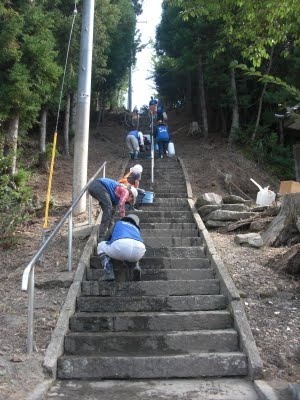
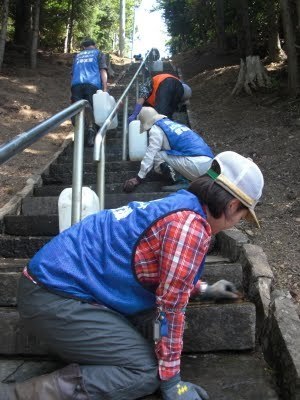 Some teams worked with the fishermen helping to cut ropes in preparation for wakame cultivation, an alternative to oyster farming which was heavily damaged and takes longer to revive. The port area had sunk about one meter; high tides now inundate the pier.
Some teams worked with the fishermen helping to cut ropes in preparation for wakame cultivation, an alternative to oyster farming which was heavily damaged and takes longer to revive. The port area had sunk about one meter; high tides now inundate the pier.
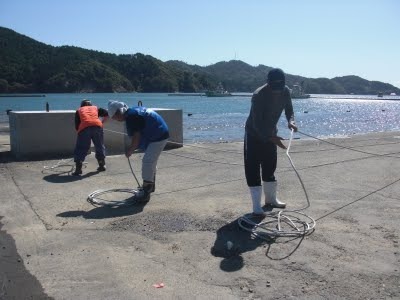 cutting rope for wakame
cutting rope for wakame
 submerged pier On day two we returned to the shrine, and our team was assigned to weed and cut grass alongside the upper steps.
submerged pier On day two we returned to the shrine, and our team was assigned to weed and cut grass alongside the upper steps.
 weeding and grass cuttingIn the afternoon, locals cut bamboo poles, and volunteers helped hoist the festival flags.
weeding and grass cuttingIn the afternoon, locals cut bamboo poles, and volunteers helped hoist the festival flags.
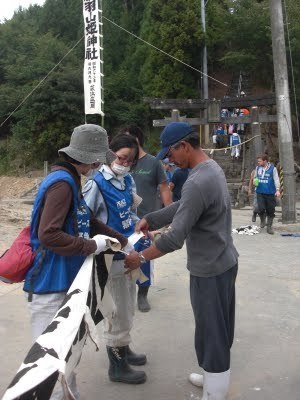 preparing the flags
preparing the flags
 festival flags hoistedWe returned to Ishinomaki via Onagawa, one of the most dramatically and brutally hit towns along the coast. The tsunami reached 18 meters in Onagawa (60 feet), even flooding the first floor of the hospital, high on a hill. Debris in Onagawa has been mostly cleared, leaving a stark, eerie and sobering landscape.
festival flags hoistedWe returned to Ishinomaki via Onagawa, one of the most dramatically and brutally hit towns along the coast. The tsunami reached 18 meters in Onagawa (60 feet), even flooding the first floor of the hospital, high on a hill. Debris in Onagawa has been mostly cleared, leaving a stark, eerie and sobering landscape.
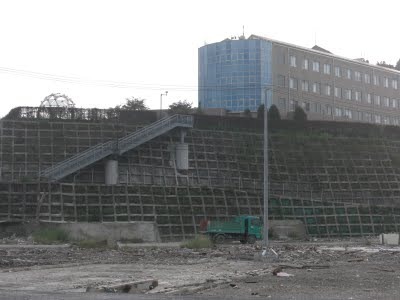 Onagawa Hospital
Onagawa Hospital
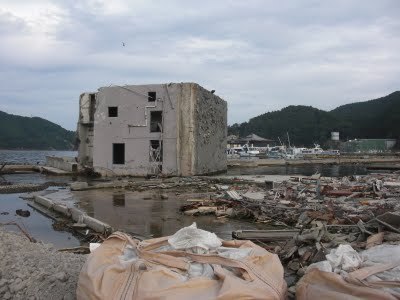 police box on its side
police box on its side
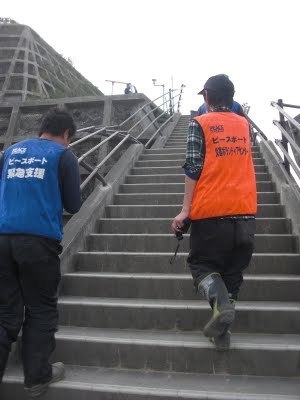 climbing up to the hospital
climbing up to the hospital
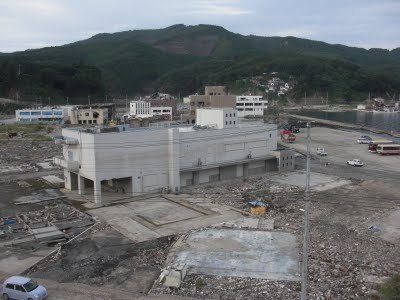 view from the hospital
view from the hospital
 view from the hospital
view from the hospital
 trying to comprehend
trying to comprehend
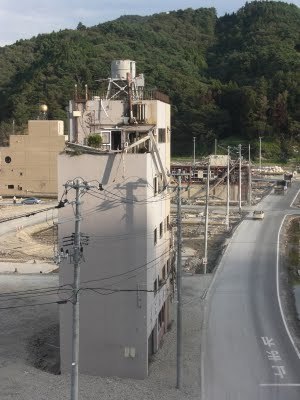 the tsunami reached the top of this buildingBack at our home base, after dinner, tsunami survivor Yoshinobu Bandai spoke to volunteers, sharing his harrowing experience of escape in Ishinomaki, his despair at hearing people's last cries for help, and the grim scenes the days after the tsunami. He implored us all to heed disaster warnings, to not hesitate in escaping to higher ground in case of tsunami, and to be wary of predicted heights of tsunami waves--in Ishinomaki the warning had been for just a six-meter wave.
the tsunami reached the top of this buildingBack at our home base, after dinner, tsunami survivor Yoshinobu Bandai spoke to volunteers, sharing his harrowing experience of escape in Ishinomaki, his despair at hearing people's last cries for help, and the grim scenes the days after the tsunami. He implored us all to heed disaster warnings, to not hesitate in escaping to higher ground in case of tsunami, and to be wary of predicted heights of tsunami waves--in Ishinomaki the warning had been for just a six-meter wave.
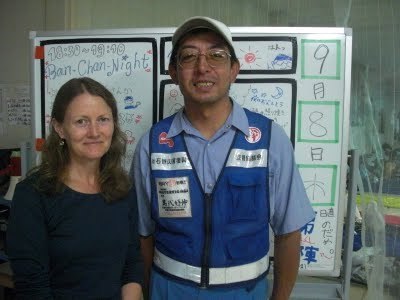 with Yoshinobu BandaiLater we watched Peace Boat's DVD of earthquake, tsunami, and volunteer efforts.
with Yoshinobu BandaiLater we watched Peace Boat's DVD of earthquake, tsunami, and volunteer efforts.
On the third and final day we returned to Oginohama for the actual matsuri (festival) event. Peace Boat volunteers set up for a barbecue then joined the priest and priestess and locals climbing the 200 very clean steps to the shrine for the ceremony.
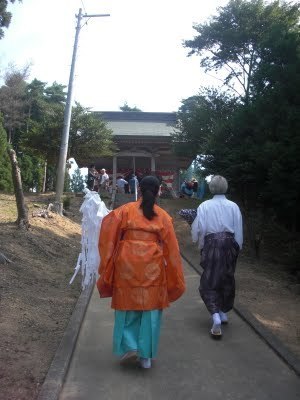 Volunteers waited in silence outside the shrine during the proceedings.
Volunteers waited in silence outside the shrine during the proceedings.
 Afterward we descended the steps...
Afterward we descended the steps...
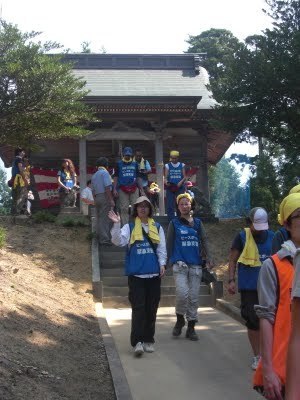 and the mikoshi (portable shrine) was brought out and carried through the harbor rubble, to the few habitable homes and temporary housing for purification rites, then out to the pier followed by the elementary school students--now only nine in the area, down from 20 due to relocation after the tsunami.
and the mikoshi (portable shrine) was brought out and carried through the harbor rubble, to the few habitable homes and temporary housing for purification rites, then out to the pier followed by the elementary school students--now only nine in the area, down from 20 due to relocation after the tsunami.
 bringing the mikoshi down the steps
bringing the mikoshi down the steps
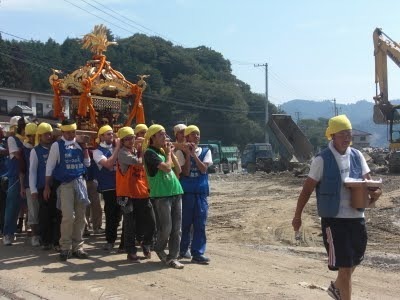 carrying the mikoshi through the port area
carrying the mikoshi through the port area
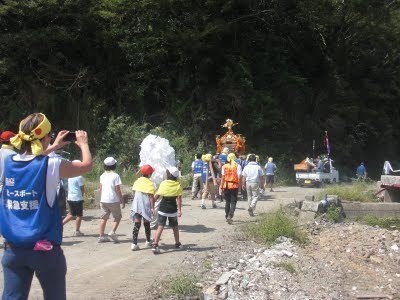 the procession
the procession
 stopping at the temporary housing unitsThe mikoshi and drums, children and priest and a few volunteers went on one boat, and most of the volunteers and locals on the others, and we chugged out into the bay toward a pair of islands. The scenery was stunning and it was difficult to imagine a tsunami on that placid sea.
stopping at the temporary housing unitsThe mikoshi and drums, children and priest and a few volunteers went on one boat, and most of the volunteers and locals on the others, and we chugged out into the bay toward a pair of islands. The scenery was stunning and it was difficult to imagine a tsunami on that placid sea.
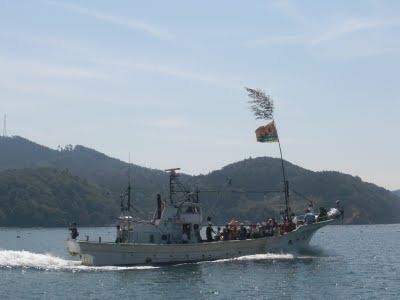

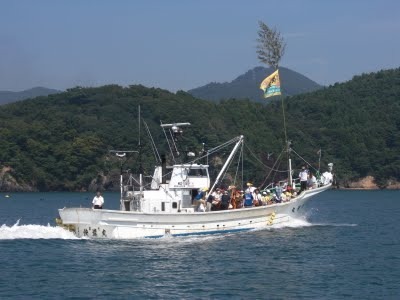 Back in the port, we cooked up the feast that Peace Boat had prepared and served the local residents who seemed to enjoy this day of community and festivity.
Back in the port, we cooked up the feast that Peace Boat had prepared and served the local residents who seemed to enjoy this day of community and festivity.
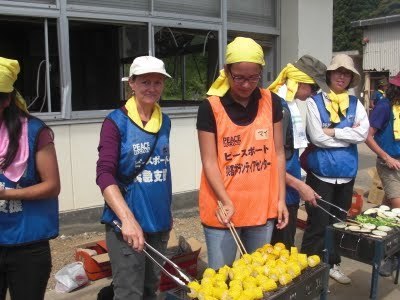 After the feast, all played Bingo and a raucous round of suika wari (blindfolded watermelon bashing) followed.
After the feast, all played Bingo and a raucous round of suika wari (blindfolded watermelon bashing) followed.

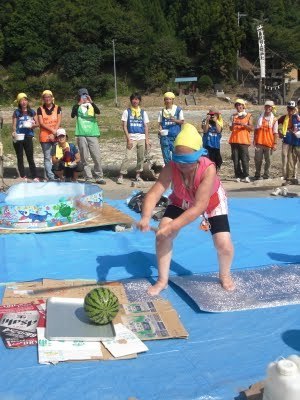
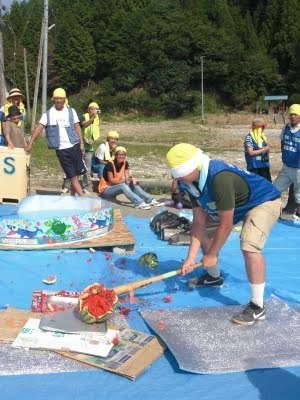 This trip to Ishinomaki was short but deeply meaningful. My teammates, once again, were amazing--patient, thoughtful, and hard-working.
This trip to Ishinomaki was short but deeply meaningful. My teammates, once again, were amazing--patient, thoughtful, and hard-working.
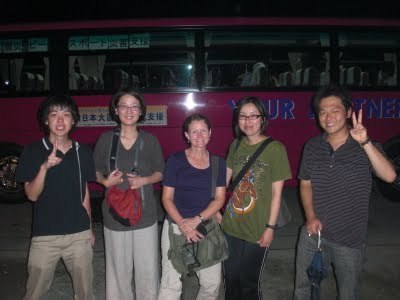 my team departing IshinomakiAnd Peace Boat staff members, selfless volunteers themselves, continue to awe and impress me. I am so grateful for these brief opportunities to join them in helping Tohoku recover.
my team departing IshinomakiAnd Peace Boat staff members, selfless volunteers themselves, continue to awe and impress me. I am so grateful for these brief opportunities to join them in helping Tohoku recover.
 our lodgingsConditions for volunteers have changed dramatically since my first trip when we had to bring our own tents, food, water and gear. Now most gear can be borrowed, lunch and dinner are served, water is available, tents are not necessary, and there are even...daily showers.
our lodgingsConditions for volunteers have changed dramatically since my first trip when we had to bring our own tents, food, water and gear. Now most gear can be borrowed, lunch and dinner are served, water is available, tents are not necessary, and there are even...daily showers. shower stallsAnd Ishinomaki itself looked quite different from the sludge shoveling days of spring. Most of the debris has been heaped into organized mountains, mud has been removed, destroyed cars have been gathered and stacked, and shells of houses stand amid cleared open areas now filling with weeds.
shower stallsAnd Ishinomaki itself looked quite different from the sludge shoveling days of spring. Most of the debris has been heaped into organized mountains, mud has been removed, destroyed cars have been gathered and stacked, and shells of houses stand amid cleared open areas now filling with weeds.  debris mountain
debris mountain
 miles and miles of damaged homes The volunteer work that our team was assigned to do was all in the same location--Oginohama, a small fishing community part way out the Oshika Peninsula. The tsunami had overrun the fishing port and poured over the torii gate at the base of the shrine. Our efforts for the three days were to ready the shrine and surrounding grounds so that the locals remaining in the area could hold their important annual shrine festival. On day one, many teams worked together to clean the neglected 200 steps up to the mountaintop shrine, scrubbing away moss and mud for hours on end.
miles and miles of damaged homes The volunteer work that our team was assigned to do was all in the same location--Oginohama, a small fishing community part way out the Oshika Peninsula. The tsunami had overrun the fishing port and poured over the torii gate at the base of the shrine. Our efforts for the three days were to ready the shrine and surrounding grounds so that the locals remaining in the area could hold their important annual shrine festival. On day one, many teams worked together to clean the neglected 200 steps up to the mountaintop shrine, scrubbing away moss and mud for hours on end.
 Some teams worked with the fishermen helping to cut ropes in preparation for wakame cultivation, an alternative to oyster farming which was heavily damaged and takes longer to revive. The port area had sunk about one meter; high tides now inundate the pier.
Some teams worked with the fishermen helping to cut ropes in preparation for wakame cultivation, an alternative to oyster farming which was heavily damaged and takes longer to revive. The port area had sunk about one meter; high tides now inundate the pier. cutting rope for wakame
cutting rope for wakame
 submerged pier On day two we returned to the shrine, and our team was assigned to weed and cut grass alongside the upper steps.
submerged pier On day two we returned to the shrine, and our team was assigned to weed and cut grass alongside the upper steps. weeding and grass cuttingIn the afternoon, locals cut bamboo poles, and volunteers helped hoist the festival flags.
weeding and grass cuttingIn the afternoon, locals cut bamboo poles, and volunteers helped hoist the festival flags. preparing the flags
preparing the flags
 festival flags hoistedWe returned to Ishinomaki via Onagawa, one of the most dramatically and brutally hit towns along the coast. The tsunami reached 18 meters in Onagawa (60 feet), even flooding the first floor of the hospital, high on a hill. Debris in Onagawa has been mostly cleared, leaving a stark, eerie and sobering landscape.
festival flags hoistedWe returned to Ishinomaki via Onagawa, one of the most dramatically and brutally hit towns along the coast. The tsunami reached 18 meters in Onagawa (60 feet), even flooding the first floor of the hospital, high on a hill. Debris in Onagawa has been mostly cleared, leaving a stark, eerie and sobering landscape. Onagawa Hospital
Onagawa Hospital
 police box on its side
police box on its side climbing up to the hospital
climbing up to the hospital
 view from the hospital
view from the hospital
 view from the hospital
view from the hospital trying to comprehend
trying to comprehend
 the tsunami reached the top of this buildingBack at our home base, after dinner, tsunami survivor Yoshinobu Bandai spoke to volunteers, sharing his harrowing experience of escape in Ishinomaki, his despair at hearing people's last cries for help, and the grim scenes the days after the tsunami. He implored us all to heed disaster warnings, to not hesitate in escaping to higher ground in case of tsunami, and to be wary of predicted heights of tsunami waves--in Ishinomaki the warning had been for just a six-meter wave.
the tsunami reached the top of this buildingBack at our home base, after dinner, tsunami survivor Yoshinobu Bandai spoke to volunteers, sharing his harrowing experience of escape in Ishinomaki, his despair at hearing people's last cries for help, and the grim scenes the days after the tsunami. He implored us all to heed disaster warnings, to not hesitate in escaping to higher ground in case of tsunami, and to be wary of predicted heights of tsunami waves--in Ishinomaki the warning had been for just a six-meter wave. with Yoshinobu BandaiLater we watched Peace Boat's DVD of earthquake, tsunami, and volunteer efforts.
with Yoshinobu BandaiLater we watched Peace Boat's DVD of earthquake, tsunami, and volunteer efforts. On the third and final day we returned to Oginohama for the actual matsuri (festival) event. Peace Boat volunteers set up for a barbecue then joined the priest and priestess and locals climbing the 200 very clean steps to the shrine for the ceremony.
 Volunteers waited in silence outside the shrine during the proceedings.
Volunteers waited in silence outside the shrine during the proceedings. Afterward we descended the steps...
Afterward we descended the steps...  and the mikoshi (portable shrine) was brought out and carried through the harbor rubble, to the few habitable homes and temporary housing for purification rites, then out to the pier followed by the elementary school students--now only nine in the area, down from 20 due to relocation after the tsunami.
and the mikoshi (portable shrine) was brought out and carried through the harbor rubble, to the few habitable homes and temporary housing for purification rites, then out to the pier followed by the elementary school students--now only nine in the area, down from 20 due to relocation after the tsunami. bringing the mikoshi down the steps
bringing the mikoshi down the steps
 carrying the mikoshi through the port area
carrying the mikoshi through the port area
 the procession
the procession
 stopping at the temporary housing unitsThe mikoshi and drums, children and priest and a few volunteers went on one boat, and most of the volunteers and locals on the others, and we chugged out into the bay toward a pair of islands. The scenery was stunning and it was difficult to imagine a tsunami on that placid sea.
stopping at the temporary housing unitsThe mikoshi and drums, children and priest and a few volunteers went on one boat, and most of the volunteers and locals on the others, and we chugged out into the bay toward a pair of islands. The scenery was stunning and it was difficult to imagine a tsunami on that placid sea.

 Back in the port, we cooked up the feast that Peace Boat had prepared and served the local residents who seemed to enjoy this day of community and festivity.
Back in the port, we cooked up the feast that Peace Boat had prepared and served the local residents who seemed to enjoy this day of community and festivity. After the feast, all played Bingo and a raucous round of suika wari (blindfolded watermelon bashing) followed.
After the feast, all played Bingo and a raucous round of suika wari (blindfolded watermelon bashing) followed.

 This trip to Ishinomaki was short but deeply meaningful. My teammates, once again, were amazing--patient, thoughtful, and hard-working.
This trip to Ishinomaki was short but deeply meaningful. My teammates, once again, were amazing--patient, thoughtful, and hard-working. my team departing IshinomakiAnd Peace Boat staff members, selfless volunteers themselves, continue to awe and impress me. I am so grateful for these brief opportunities to join them in helping Tohoku recover.
my team departing IshinomakiAnd Peace Boat staff members, selfless volunteers themselves, continue to awe and impress me. I am so grateful for these brief opportunities to join them in helping Tohoku recover.
Published on September 13, 2011 08:17
September 5, 2011
Orchards Giveaway for World Suicide Prevention Day
 In honor of World Suicide Prevention Day on September 10, I will be giving away five copies of my young adult verse novel Orchards to middle or high school students, or teachers, librarians or parents of middle or high schools students. I will mail the copies to addresses anywhere in the world. To qualify, please leave a comment on this blog post below (these will be moderated) and include a few words about why you'd like to receive a copy of Orchards. I will draw five names on September 10 sometime in the evening EDT (morning September 11 Japan time).
In honor of World Suicide Prevention Day on September 10, I will be giving away five copies of my young adult verse novel Orchards to middle or high school students, or teachers, librarians or parents of middle or high schools students. I will mail the copies to addresses anywhere in the world. To qualify, please leave a comment on this blog post below (these will be moderated) and include a few words about why you'd like to receive a copy of Orchards. I will draw five names on September 10 sometime in the evening EDT (morning September 11 Japan time).World Suicide Prevention Day aims to raise awareness around the globe that suicide can be prevented. The 2011 theme is "Preventing Suicide in Multicultural Societies." Toolkits, suggested activities and information are available via the International Association for Suicide Prevention. See what you can do to help prevent suicide, from wherever you are in the world.
Published on September 05, 2011 19:10
August 31, 2011
Typhoon 12 Cloud and Surf Action
Typhoon number 12, or Typhoon Talas, is headed straight for central Japan. I cycled down to the beach in Kamakura just before sunset to check out the wave and cloud action. The tide was nearly high, and waves were surging up to the lifeguard stations and flooding into the beach road underpasses. People were scurrying about securing boats, fishing equipment and beach restaurant paraphernalia.
Surfers seemed happy though, as did a maniac kayaker. The light was constantly changing, the surf charging then quieting then raging. These photos were taken from one location on the beach within a time span of just 30 minutes.
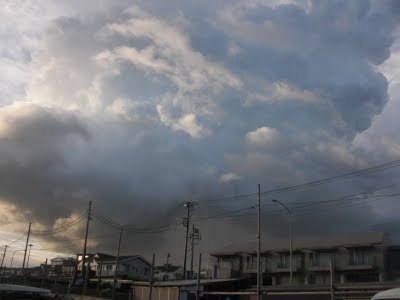



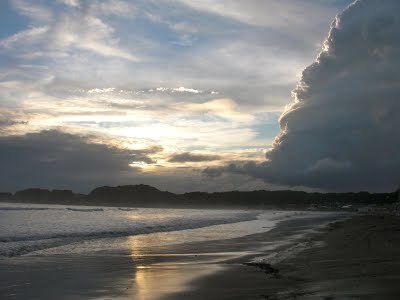
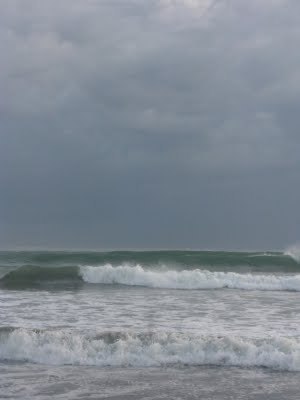
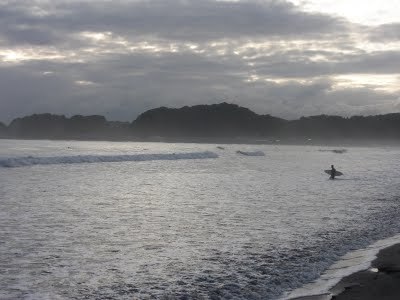
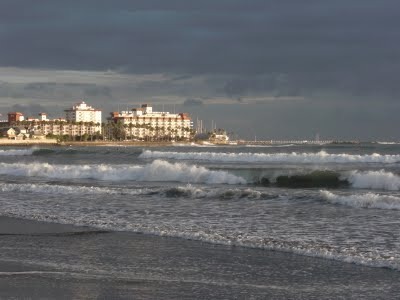
 Our bikes and potted plants have been secured or brought indoors, laundry poles have been stowed, humidity is now at 95%...now just to wait as Typhoon 12号 slowly approaches. Happy last day of August!
Our bikes and potted plants have been secured or brought indoors, laundry poles have been stowed, humidity is now at 95%...now just to wait as Typhoon 12号 slowly approaches. Happy last day of August!
Surfers seemed happy though, as did a maniac kayaker. The light was constantly changing, the surf charging then quieting then raging. These photos were taken from one location on the beach within a time span of just 30 minutes.








 Our bikes and potted plants have been secured or brought indoors, laundry poles have been stowed, humidity is now at 95%...now just to wait as Typhoon 12号 slowly approaches. Happy last day of August!
Our bikes and potted plants have been secured or brought indoors, laundry poles have been stowed, humidity is now at 95%...now just to wait as Typhoon 12号 slowly approaches. Happy last day of August!
Published on August 31, 2011 05:34
August 24, 2011
Minka and Novel Revision
The other day I had a chance to visit the home of Yoshihiro Takishita, architect and minka (old Japanese houses) preservationist. During our visit, in one eighteenth-century minka of the gassho zukuri peaked-roof style on Takishita's property, he was explaining the dismantling and moving process of that enormous farmhouse from the snow country (where it was to be discarded). He spoke of removing the roof, the walls, the sliding doors, the floors, and then carefully taking apart the posts and beams with their mortise and tenon joinery and the massive curved beams that weave over and under and lock into place. "It is really just the skeleton that we move," he said. And I realized that was exactly the process I was undergoing with my current novel.
In my novel revisions, I have had to remove the roof, tear down the walls, pull up the floorboards and remove the doors. And I have hammered the pegs out of tongue and groove joints and taken apart chapters and poems and stanzas beam by beam. The beams and posts exposed and dismantled, I have taken the pieces and moved them not to a different part of the country as often happens with minka, but forward in time and situation. And now I am undergoing the process of reconstruction--reassembling the frame, repairing structural problems, recarving some problematic posts, and little by little adding new walls, flooring and roof.
It is a tedious process, and I often wish I had physical pieces to actually manipulate. But it helped me to see the minka, to see the intricate joinery work, to gaze up into the lashed roof beams, to study how pine beams of enormous girth could be woven together, and to think of the labor behind the final product. I was reminded of the patience required of minka craftsmen...and I am inspired to keep rebuilding and refining my novel.

Yanohara House, Sankeien (Wikimedia Commons)
You don't have to go to Japan's snow country to see minka. You can spot them here and there throughout Japan, even in greater Tokyo. In Yokohama, you can enter the preserved gassho zukuri style minka, the Yanohara House. And just outside of Tokyo in Kawasaki, the Nihon Minkaen is an excellent place to spend a day exploring minka moved from all around Japan. Davina Pardo recently made the documentary film Minka about Takishita's home--I'm eager to get to a screening.
In my novel revisions, I have had to remove the roof, tear down the walls, pull up the floorboards and remove the doors. And I have hammered the pegs out of tongue and groove joints and taken apart chapters and poems and stanzas beam by beam. The beams and posts exposed and dismantled, I have taken the pieces and moved them not to a different part of the country as often happens with minka, but forward in time and situation. And now I am undergoing the process of reconstruction--reassembling the frame, repairing structural problems, recarving some problematic posts, and little by little adding new walls, flooring and roof.
It is a tedious process, and I often wish I had physical pieces to actually manipulate. But it helped me to see the minka, to see the intricate joinery work, to gaze up into the lashed roof beams, to study how pine beams of enormous girth could be woven together, and to think of the labor behind the final product. I was reminded of the patience required of minka craftsmen...and I am inspired to keep rebuilding and refining my novel.

Yanohara House, Sankeien (Wikimedia Commons)
You don't have to go to Japan's snow country to see minka. You can spot them here and there throughout Japan, even in greater Tokyo. In Yokohama, you can enter the preserved gassho zukuri style minka, the Yanohara House. And just outside of Tokyo in Kawasaki, the Nihon Minkaen is an excellent place to spend a day exploring minka moved from all around Japan. Davina Pardo recently made the documentary film Minka about Takishita's home--I'm eager to get to a screening.
Published on August 24, 2011 21:37
August 6, 2011
Yukata Contest
In my novel Orchards, Kana is presented with a yukata by her grandmother. In my novel Ash, Caitlin recalls the pair of yukata that Mie's grandmother had made for them. It's hard to write a novel set in Japan in summer without mentioning yukata. It's hard to imagine summer in Japan without yukata, the summer kimono, worn especially for bon odori dancing, fireworks and festivals.
This year I joined a local dance circle, and my dance teacher cajoled me into entering a yukata contest at a big temple festival in Fujisawa. I have several ordinary yukata of my own, but members of the circle suggested one of the teacher's yukata with a willow and umbrella design. Another member loaned a linen obi. The teacher's daughter made me a hairpin with handblown glass. They helped me dress, tied the obi, put up my hair and I was ready to go.
Up on stage, contestants were asked questions--details about their yukata and obi. I had practiced a few responses, and fortunately they didn't throw me any tough questions.
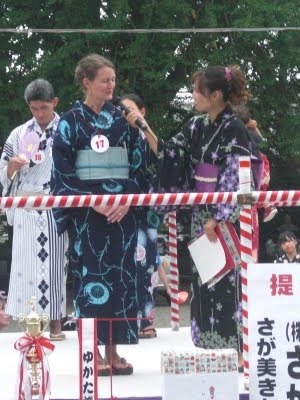 This man had made his own yukata and urged more men to enjoy wearing yukata in summer.
This man had made his own yukata and urged more men to enjoy wearing yukata in summer.
 Some of the other yukata and obi were stunning. I loved this hand-painted obi.
Some of the other yukata and obi were stunning. I loved this hand-painted obi.
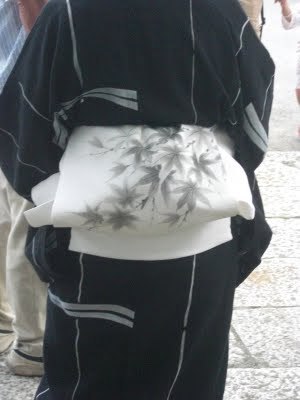 Much to my surprise my name was announced for first runner up.
Much to my surprise my name was announced for first runner up.
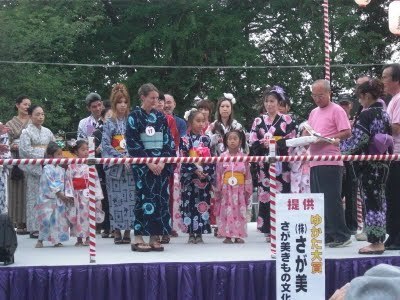 I was presented with a sash, a gift and a cash award.
I was presented with a sash, a gift and a cash award.
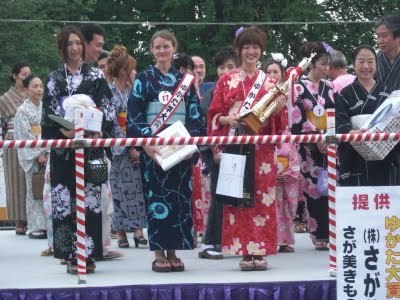 And photos followed.
And photos followed.
 And more photos.
And more photos.
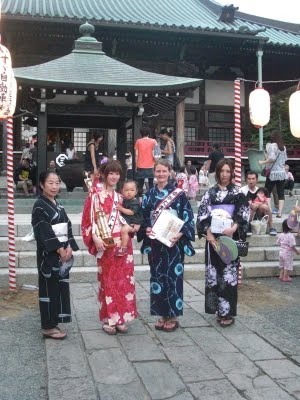 And after the contest, the music started, and huge crowds danced the tanko bushi and other Obon dances around the dais. It was a crazy, fun evening.
And after the contest, the music started, and huge crowds danced the tanko bushi and other Obon dances around the dais. It was a crazy, fun evening.
My dance teacher first learned to dance in her hometown of Kesennuma, a city in northeast Miyagi Prefecture that was ravaged by the March 11 tsunami. As I've told her, I already know where I'm sending my prize money.
This year I joined a local dance circle, and my dance teacher cajoled me into entering a yukata contest at a big temple festival in Fujisawa. I have several ordinary yukata of my own, but members of the circle suggested one of the teacher's yukata with a willow and umbrella design. Another member loaned a linen obi. The teacher's daughter made me a hairpin with handblown glass. They helped me dress, tied the obi, put up my hair and I was ready to go.
Up on stage, contestants were asked questions--details about their yukata and obi. I had practiced a few responses, and fortunately they didn't throw me any tough questions.
 This man had made his own yukata and urged more men to enjoy wearing yukata in summer.
This man had made his own yukata and urged more men to enjoy wearing yukata in summer. Some of the other yukata and obi were stunning. I loved this hand-painted obi.
Some of the other yukata and obi were stunning. I loved this hand-painted obi. Much to my surprise my name was announced for first runner up.
Much to my surprise my name was announced for first runner up. I was presented with a sash, a gift and a cash award.
I was presented with a sash, a gift and a cash award. And photos followed.
And photos followed. And more photos.
And more photos. And after the contest, the music started, and huge crowds danced the tanko bushi and other Obon dances around the dais. It was a crazy, fun evening.
And after the contest, the music started, and huge crowds danced the tanko bushi and other Obon dances around the dais. It was a crazy, fun evening.My dance teacher first learned to dance in her hometown of Kesennuma, a city in northeast Miyagi Prefecture that was ravaged by the March 11 tsunami. As I've told her, I already know where I'm sending my prize money.
Published on August 06, 2011 18:45
August 2, 2011
Taking to the Hills--Kamakura Hiking
Kamakura has hiking trails winding all through its hills. Midsummer they are cool and serene, quiet save for cicadas and bush warblers. The hills climb fast to panoramic vistas and long ridges that skirt finger-like valleys. After rains the forests are lush. Ferns are hip high. Fan palms hide the trail. And here and there are caves, tiny shrines, rows of tombstones—marks of history. Worn stones reveal where others have stepped…for centuries. One of the paths I walk leads past the Takatoki hara-kiri caves. Another goes by Mandara-do with its multi-storied cave tombs. Kamakura has hundreds of burial caves from the Kamakura era dug into cliffsides. Many are filled with gorinto, stupas of five-element "rings" representing from bottom to top earth, water, fire, wind, space. There are still paths I haven't explored in all these years in Kamakura, and even on the paths I've hiked many times, I'm always discovering something I hadn't noticed before. This summer I am exploring the trails. Between writing and editing, I am taking to the hills. Some days are for running, some days are for beach walks, but other days I need a hike.
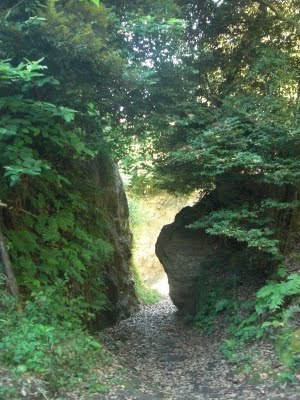 Nagoe Kiridoshi
Nagoe Kiridoshi
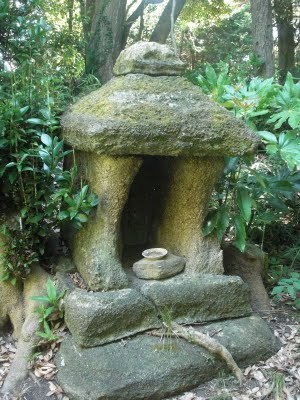
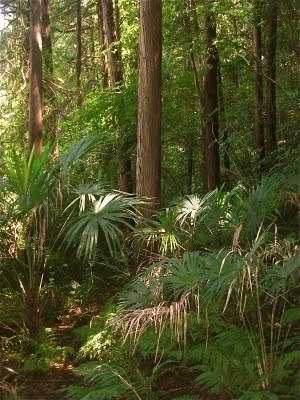
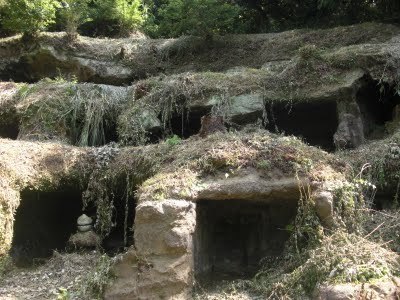 Mandara-do yagura (cave tombs)
Mandara-do yagura (cave tombs)
 Mandara-do yagura with many gorinto
Mandara-do yagura with many gorinto

 View of Kamakura
View of Kamakura
Published on August 02, 2011 00:04
July 16, 2011
A neighborhood festival on the four-month anniversary
Recently the four-month anniversary of the March 11 earthquake was marked with ceremonies, as well as assessments of the clean-up work and conditions for evacuees and survivors. Despite constant efforts, sixty percent of the tsunami debris remains to be cleared. The summer heat has been intense since the beginning of July, and conditions for volunteers and locals in Tohoku have been especially tough. Progress happens though, as one volunteer put it, bag by bag. Here is a wonderful account by a volunteer I met when I went to Tohoku with the NGO Peace Boat, and here are two blog posts showing what teams of volunteers can accomplish in just two days of work: before and after.
In my Kamakura neighborhood, the four-month anniversary coincided with the annual summer matsuri, a shrine festival dating back hundreds of years. Major events like the Kamakura fireworks have been canceled this year, but local festivals that celebrate community are still on.
 Parading the mikoshi (portable) shrine through the streets
Parading the mikoshi (portable) shrine through the streets
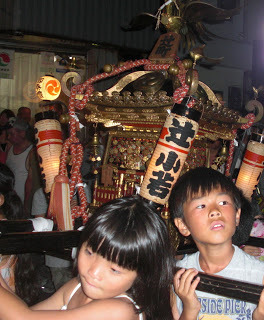 Child-size mikoshi
Child-size mikoshi
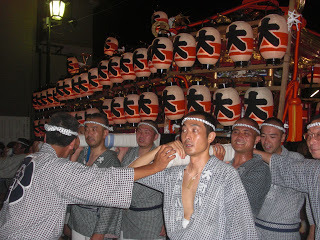 Four mikoshi tied together and carried in tandem through the streetsThroughout the weekend, the theme was helping Tohoku and encouraging Japan. The lottery featured many products from Tohoku.
Four mikoshi tied together and carried in tandem through the streetsThroughout the weekend, the theme was helping Tohoku and encouraging Japan. The lottery featured many products from Tohoku.
 A woman waves a fan with a winning lottery numberTurnout for the festival was higher than in past years, with far more families and individuals participating than usual. The culminating event was Bon Odori dancing on the grounds of the small shrine, founded in 1082.
A woman waves a fan with a winning lottery numberTurnout for the festival was higher than in past years, with far more families and individuals participating than usual. The culminating event was Bon Odori dancing on the grounds of the small shrine, founded in 1082.
 A dance group leads off Bon OdoriIn the lantern- and moonlight, men and women, young children and older people, danced round and round a huge old tabu no ki tree. Just a few joined in at first, then more, and more, and more. Last year we were a trickle. This year, instead of a single ring, we were multiple rings, a neighborhood throng circling that tree.
A dance group leads off Bon OdoriIn the lantern- and moonlight, men and women, young children and older people, danced round and round a huge old tabu no ki tree. Just a few joined in at first, then more, and more, and more. Last year we were a trickle. This year, instead of a single ring, we were multiple rings, a neighborhood throng circling that tree.
No one wanted the dances to end. Each time the music stopped there were calls for more. Round and round that great old tree, a huge circle of community seemed to be saying, "Together we can do this."
In my Kamakura neighborhood, the four-month anniversary coincided with the annual summer matsuri, a shrine festival dating back hundreds of years. Major events like the Kamakura fireworks have been canceled this year, but local festivals that celebrate community are still on.
 Parading the mikoshi (portable) shrine through the streets
Parading the mikoshi (portable) shrine through the streets
 Child-size mikoshi
Child-size mikoshi
 Four mikoshi tied together and carried in tandem through the streetsThroughout the weekend, the theme was helping Tohoku and encouraging Japan. The lottery featured many products from Tohoku.
Four mikoshi tied together and carried in tandem through the streetsThroughout the weekend, the theme was helping Tohoku and encouraging Japan. The lottery featured many products from Tohoku. A woman waves a fan with a winning lottery numberTurnout for the festival was higher than in past years, with far more families and individuals participating than usual. The culminating event was Bon Odori dancing on the grounds of the small shrine, founded in 1082.
A woman waves a fan with a winning lottery numberTurnout for the festival was higher than in past years, with far more families and individuals participating than usual. The culminating event was Bon Odori dancing on the grounds of the small shrine, founded in 1082. A dance group leads off Bon OdoriIn the lantern- and moonlight, men and women, young children and older people, danced round and round a huge old tabu no ki tree. Just a few joined in at first, then more, and more, and more. Last year we were a trickle. This year, instead of a single ring, we were multiple rings, a neighborhood throng circling that tree.
A dance group leads off Bon OdoriIn the lantern- and moonlight, men and women, young children and older people, danced round and round a huge old tabu no ki tree. Just a few joined in at first, then more, and more, and more. Last year we were a trickle. This year, instead of a single ring, we were multiple rings, a neighborhood throng circling that tree.No one wanted the dances to end. Each time the music stopped there were calls for more. Round and round that great old tree, a huge circle of community seemed to be saying, "Together we can do this."
Published on July 16, 2011 02:56



